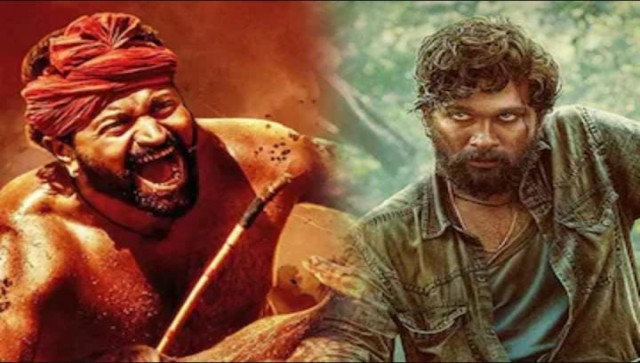The success and failure of cinema cannot be a matter of mathematical formulation or snap judgments so questions like what Hindi cinema is doing wrong are simplistic. It would be better to ask what regional cinema is getting right. The numbers are on the wall, so let us begin with a few. Kantara, Rishab Shetty’s superhit Kannada thriller was made just about 16 crores rupees and has earned over 360 crores rupees and counting at the box office. This is the second highest-grossing Kannada film of all time. Tamil epic Ponniyin Selvan began with a budget of ₹500 crores which then was split into two parts and the film has already recovered its cost even before the release of the sequel. Telugu action entertainer Pushpa: The Rise was budgeted at 170–250 crore rupees and in 2021 grossed over 355–365 crores rupees at the box office. Telugu film Sarkaru Vaari Paata made on a budget of Rs 60 crores, earned Rs 230 crores worldwide while Kannada film KGF 2 made on a budget of Rs100 crores, earned between 1,200–1,250 crore rupees at the box office. The point these numbers make is that even massive filmmaking budgets have to be justified on screen in terms of compelling storytelling as in the case of PS 1. The most important question, in my opinion, that we need to ask is just exactly where the money is going when a film is being made. Is it being invested in the film’s overall betterment or is a major chunk being used up to pay the star cast? Whether we acknowledge it or not, the audiences have evolved faster than expected and are no longer patient with unexceptional narratives. They are language agnostic, open to relishing any content that engages them and are looking for a distinct cinematic experience that makes them want to spend their hard-earned time and money. In the past few years, regional cinema has transcended its geography and traditional demographics to win over audiences all over India and even abroad. The hysteria over RRR in Japan and the Oscar buzz around it proves that regional cinema has come a long way from the time when Telugu, Kannada, and Tamil action films were dubbed in Hindi, given strange titles, and shown on TV. Today pan Indian audiences queue up to watch Kannada, Telugu, Malayalam, and Tamil blockbusters in theatres. There is a lot to learn from this shift and this is one of the reasons why we as a production house have been working extensively with various industries to understand their creative and economic dynamics and to synergise with them. Today, we cannot make films sticking to a singular formula where a star is supposed to be the main draw and every other aspect of the creative process is neglected. People are looking for a beating heart, stirring emotion, passion, and surpassing joy in stories and if star vehicles fail to offer that, they will be rejected. A franchise like Baahubali did phenomenally well in India and in overseas markets because it was larger-than-life cinema at its best. A small-budget Marathi film like Sairat did very well even beyond Maharashtra because it had a very powerful theme. The Hindi film industry is today competing not just with content from all over the world on OTT streamers but also films like Kantara which immerse the non-Kannada speaking audience in a world of myth and traditions they never knew existed in their own country. People are now looking for rooted cinema following the old adage that the more local a hero, the more universal he becomes. Kantara, is very local in its idiom and was literally shot in the filmmaker’s own village but has gone universal because it taps into a revival of pride in our own identity. This is not just happening in India but worldwide because everyone is now looking to connect to their roots and learn more about who we are and where they came from. People are getting DNA ancestry tests done and want to embrace who they are. This hunger is driving the demand for rooted cinema and because the budgets have always been lower in regional markets, the stakes are lower and there is greater space for experimentation. This has led to a great ecosystem of raw and untapped talent and to the emergence of local stories with universal appeal. Everyone is looking for the next pan-Indian hit and so regional and even Hindi films are today being dubbed and released in multiple languages. Makers are realising the potential of reaching out to a diverse audience while film-goers are discovering the joy of consuming variegated content across languages. This is why the Gujarati film Chal Jeevi Laye did so well nationally. All this is now leading to the growth of OTT mainly in vernacular languages and people are now looking to watch rooted content across languages from the comfort of their homes. What is however clear as daylight is that nobody can take the audience for granted anymore. This is a lesson filmmakers cannot ignore, no matter which language they are telling their stories in_._ The author is Senior Vice President of Films & Events at Saregama India Ltd. Views expressed are personal. Read all the Latest News , Trending News , Cricket News , Bollywood News , India News and Entertainment News here. Follow us on Facebook , Twitter and Instagram .
From Pushpa to Kantara: Here is what regional cinema is getting right
Siddharth Anand Kumar
• December 5, 2022, 15:56:44 IST
It is clear that nobody can take the audience for granted anymore. This is a lesson filmmakers cannot ignore, no matter which language they are telling their stories in
Advertisement
)
End of Article